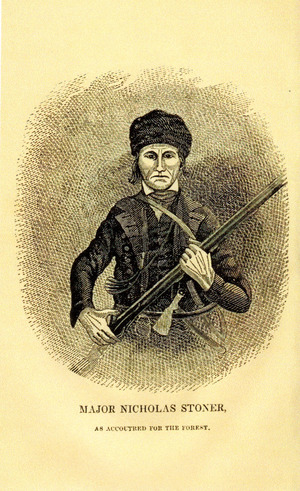Nicholas Stoner facts for kids
Nicholas Stoner (born December 15, 1762, in Maryland – died November 26, 1853, in Caroga, New York) was a famous hunter and trapper. He lived in the Adirondack Mountains of New York. Nicholas Stoner was also a brave soldier. He fought in the Continental Army during the American Revolution and later in the War of 1812. He is buried in Prospect Hill Cemetery in Gloversville, New York.
Contents
Who Was Nicholas Stoner?
Nicholas Stoner was a real American hero. He was known for his amazing skills as a hunter and trapper. He spent a lot of time exploring the wild forests of the Adirondack Mountains. But he wasn't just an outdoorsman. Stoner also played an important part in two major American wars.
Growing Up
Nicholas Stoner was born in Maryland in 1762. His father, Henry Stoner, was an immigrant from Germany. His mother was Catherine Barnes. When Nicholas was a child, his family moved to New York City. His uncle, John Binkus, helped pay for his schooling there. After a few years, the family moved again. They settled in a frontier area called "Fonda's Bush." Today, this place is known as Broadalbin in Fulton County, New York.
A Young Soldier: The Revolutionary War
In 1777, when he was about 15, Nicholas Stoner joined the army. He became a fifer for the Patriot forces. A fifer plays a small flute called a fife, which was used to give signals to soldiers. His father and younger brother, John, also served in the same army group.
Brave Moments in Battle
In August 1777, Stoner's unit helped General Benedict Arnold at Fort Stanwix. Later that year, they fought in the important Battles of Saratoga. Nicholas Stoner was with General Arnold during an attack on a Hessian camp. Hessians were German soldiers fighting for the British. During this battle, Arnold was hurt, and Stoner was also wounded on the right side of his head and ear.
After he recovered, Stoner served in Rhode Island. There, his father was wounded, and Nicholas was captured. But he was later set free. In 1780, it is said that he was part of the guard for Major John André. André was a British spy who was being taken to be executed. In 1781, Stoner was at Yorktown. This was where the British army finally surrendered, ending the main part of the war.
In 1782, a sad event happened. Nicholas's father, who had left the army, was killed by a group of Native Americans. This happened on his farm in Tribes Hill, New York. In 1783, Nicholas went with Colonel Marinus Willett to New York City. This was when the British left the city for good.
Life After the War
After the war, Nicholas Stoner went back to Johnstown. He married Anna Mason, who was a young widow with a daughter named Mary. Nicholas and Anna had six more children together. They had four sons: John, Jeremiah, Henry, and Obediah. They also had two daughters: Mary and Catherine.
The family first lived near Johnson Hall. Then they moved to Scotch Bush, which is now in the town of Florida. Nicholas Stoner worked as a deputy sheriff for a while. He also held other jobs in the town. During this time, he became very well known for his hunting and trapping skills. He mostly hunted in the area around the Sacandaga River.
Nicholas and Anna were married for over forty years. After Anna died in 1824, Nicholas lived with a woman named Polly Phye for many years. Later, in 1840, Stoner married a younger widow named Hannah Frank. He then lived in Caroga, New York.
Fighting Again: The War of 1812
When the War of 1812 began, both Nicholas and his brother John joined the army. Sadly, John died from an illness in Sackets Harbor, New York. Nicholas joined the 29th Regiment in 1813. He became a fife-major, which is a leader of the fifers. From then on, people called him "Major Stoner."
In September 1814, he bravely fought in the Battle of Plattsburgh. In this battle, a small American army successfully fought off a much larger British force.
His Final Years
Nicholas Stoner lived a long life. He passed away at the age of 92 on November 24, 1853. He died in Newkirk's Mills, which is now Newkirk, in the town of Caroga. He was first buried in Kingsborough Cemetery in Gloversville. There is still a plaque there marking the spot. Later, his remains were moved to Prospect Hill Cemetery in Gloversville.
Remembering Nicholas Stoner
Nicholas Stoner is still remembered today. The Nick Stoner Municipal Golf Course in Caroga is named after him. It even has a large statue of him. Several lakes in the area also bear his name. These include East Stoner Lake, West Stoner Lake, and Little Stoner Lake. Nick Stoner Island in nearby Canada Lake is also named for him. The fight song for Gloversville High School used to be "Old Nick Stoner, the Man whose Praise we sing." A special type of ship, called a liberty ship, was even named SS Nick Stoner in 1944.


